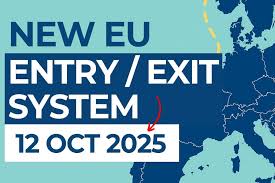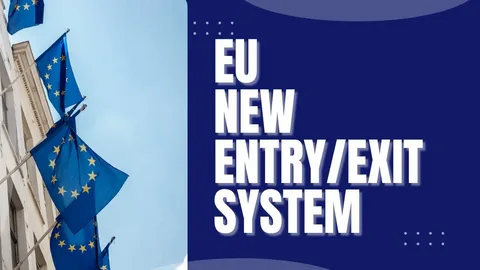From October 12, 2025, entering or leaving Europe will no longer be as simple as getting your passport stamped. A quiet revolution is taking place across the continent’s borders, one that will change how millions of travellers, including Nigerians and other non-EU citizens, move in and out of the Schengen Area.
This transformation is called the Entry/Exit System (EES), a massive digital upgrade that marks the end of traditional passport stamping and the beginning of biometric border control in the European Union.
But what does this mean for travellers? Will it make entry faster or more complicated? Who does it affect, and what should you expect when you land at a European airport after October 12?
Let’s break down clearly what the EES is, why it’s being introduced, and how it will shape the future of travel to Europe.
Understanding the EES: What Exactly Is Changing?
The Entry/Exit System (EES) is a new automated IT system developed by the European Union to register the movement of non-EU nationals when they enter or leave the Schengen Area.
Until now, border officers manually stamped passports to record entry and exit dates. This process was time-consuming, prone to errors, and made it difficult to track visa overstays. With the EES, that paper trail becomes digital.
Here’s how it works:
Every time a non-EU traveller enters or exits a Schengen country, the system will automatically record their name, travel document details, biometric data (fingerprints and facial image), and the date and place of entry or exit.
These records will be stored in a central EU database for three years after each trip.
Instead of a manual stamp, the system will instantly determine how long you’ve stayed and whether you’ve overstayed your visa-free limit or short-stay visa duration.
Essentially, EES is Europe’s new way of digitally managing border security while ensuring compliance with the 90/180-day rule, which allows visitors to stay up to 90 days within any 180-day period in the Schengen Area.
The EES will operate in all 26 Schengen countries, including major destinations such as France, Germany, Italy, Spain, the Netherlands, and others.
Who Will Be Affected by the New System?
The EES is not for everyone. It specifically applies to non-EU citizens, that is, travellers who are not nationals of any EU or Schengen Area country.
1. Short-Stay Visitors (Visa-Exempt Travellers)
If you’re from a country whose citizens can enter the Schengen Area without a visa (for instance, the UK, the U.S., or Canada), your entry and exit will now be digitally logged through the EES each time you travel.
Even though Nigerians require a Schengen visa, this change still matters, as it affects how visa entries and stays are monitored.
2. Visa Holders (Schengen Short-Stay Visa)
For Nigerians and other travellers who require a short-stay visa (Type C) to visit Europe, your biometric data will already be captured during your visa application. However, the EES will still record your entry and exit movements, ensuring that your stay duration aligns with what your visa permits.
In short, all third-country nationals — regardless of whether they need a visa or not — will be affected.
The Rollout: How the EES Will Be Implemented
The official rollout date is October 12, 2025, but implementation will occur progressively across airports, land borders, and seaports in Schengen countries.
At Airports
Most airports are setting up self-service kiosks or automated gates equipped with biometric scanners. Travellers will use these machines to:
Scan their passport or travel document,
Capture their fingerprints and facial image,
And confirm their entry or exit digitally.
Border officers will supervise the process, but most of it will be automated.
At Land Borders
The rollout at land crossings — for example, between France and Switzerland or between Poland and non-EU neighbors — will be more complex. Border posts are being upgraded to include EES registration booths, though authorities have warned that initial delays may occur during the first few months of transition.
At Seaports
Travellers entering through ferries or cruise terminals will also go through biometric checks and registration.
In essence, the EES will replace passport stamps with digital entries, and border crossings will rely heavily on biometric identity verification.
Why the EU Is Introducing the Entry/Exit System
Europe’s border management has relied on physical passport stamps for decades — a system that worked reasonably well but offered little security intelligence. The EES represents a data-driven modernisation of how Europe handles migration and travel.
The main goals include:
Stronger Security: By collecting biometric data, the system makes it harder for individuals to enter with false documents or identities.
Accurate Tracking: It will automatically detect travellers who overstay their visa or violate travel limits.
Faster Border Checks: Once the system is fully operational, repeat travellers can be processed faster through automation.
Data Sharing Across Europe: All Schengen countries will share the same digital database, improving coordination between border and immigration authorities.
This new framework also helps Europe prepare for another major initiative — ETIAS.
The Connection Between EES and ETIAS
The European Travel Information and Authorisation System (ETIAS) is another upcoming digital system that will complement the EES.
While EES records actual entries and exits, ETIAS will handle pre-travel authorisation for visa-exempt visitors — much like the U.S. ESTA system.
How They Work Together
ETIAS: Approves travellers before they enter Europe.
EES: Records and monitors their movements after they enter.
For example, from mid-2026, if you are from a country that doesn’t need a visa to visit the Schengen Area, you’ll first need to obtain an ETIAS authorisation online before travelling.
Then, upon arrival, the EES will register your biometric data and entry details.
Together, these two systems will allow Europe to digitally control who comes in, how long they stay, and when they leave — replacing manual procedures with a fully automated chain of digital checks.
The Digital Future of Schengen Travel
The Entry/Exit System is part of a broader European vision — building a Smart Borders framework that modernises how people move in and out of Europe.
The long-term plan is to:
Replace physical passport stamps with digital records accessible across all EU countries.
Introduce self-service border control for frequent travellers.
Allow real-time tracking of overstayers and potential immigration risks.
This digital transformation aims to make travel faster for legitimate visitors while enhancing security and migration control.
But the transition won’t be without challenges. Experts predict that the first months of EES implementation could see longer queues, especially at busy airports like Paris Charles de Gaulle, Frankfurt, and Amsterdam Schiphol. Border officials are being trained, but the shift from manual to digital systems takes time.

What Travellers Should Expect at the Border
For most travellers, the border process will look something like this:
Arrival at a Schengen Port of Entry – You approach an EES-enabled kiosk or gate.
Document Scan – You insert your passport or visa into the scanner.
Biometric Capture – The system takes your facial image and fingerprints.
Verification – It checks your data against EU security and immigration databases.
Confirmation – Once verified, you’re allowed to proceed; no stamp will be added to your passport.
Your data remains stored in the system, meaning that future trips will be faster, as your biometric profile will already exist in the database.
For land borders (for instance, travellers entering by car or bus), registration may take longer initially, but the process will become smoother with time.
What Travellers Should Do to Prepare
If you’re planning to travel to Europe after October 12, here’s how to make sure you’re ready:
1. Arrive Early at Airports
Expect longer processing times, especially during the first few months of EES activation. Airlines may advise passengers to arrive at least 3 hours before departure to accommodate biometric registration.
2. Ensure Your Passport Is Valid
The EES will reject expired or damaged passports, so ensure your travel document is in good condition and valid for at least six months beyond your travel date.
3. Confirm Your Visa Details
If you hold a Schengen visa, double-check that your travel dates fall within the allowed period. The EES will track overstays automatically.
4. Stay Within Legal Limits
The system will automatically calculate your stay duration based on the 90/180-day rule. Exceeding this limit could trigger automatic entry bans on future visits.
5. Be Prepared for Biometric Registration
Your fingerprints and face image will be captured at the border. Cooperate with border officers and follow instructions carefully to speed up the process.
For Visa Applicants: How EES Affects You
If you’re applying for a Schengen visa from Nigeria or elsewhere, the EES adds a new layer of transparency.
Consulates will use EES data to:
Verify your past entries and exits,
Check if you’ve ever overstayed a previous visa,
And make more informed decisions on future visa applications.
This means travellers with clean travel histories will likely enjoy smoother visa approvals. Conversely, those who have overstayed in the past may face stricter scrutiny.
Potential Benefits and Concerns
The Advantages
Faster Processing: Once initial data is captured, repeat travel becomes faster.
Reduced Errors: No more misreading or losing stamped pages.
Better Security: More accurate identification reduces the risk of fraud or illegal entry.
The Concerns
Privacy Questions: Some travellers worry about how long biometric data will be stored and who can access it.
Transition Delays: Early users may experience longer queues as border staff adjust to new systems.
System Glitches: As with any large-scale digital system, minor technical issues could appear during rollout.
However, EU authorities have emphasized that data protection measures are robust, and all personal information will be managed under strict EU privacy laws (GDPR).
The introduction of the Entry/Exit System marks a historic shift in how Europe manages its borders. The iconic passport stamp — once a treasured souvenir for many travellers — is now giving way to a sleek, digital record that reflects a new age of smart travel.
For non-EU visitors, including Nigerians planning to study, work, or holiday in Europe, this system means greater transparency, accountability, and efficiency — but also more precision in monitoring movements.
In a world where travel is increasingly digital, the EU’s EES rollout symbolizes a larger reality: the future of international mobility is biometric, data-driven, and borderless in concept but not in control.
The Entry/Exit System is not just another border control tool it’s the foundation of Europe’s next-generation travel infrastructure.
Travellers who prepare ahead, stay informed, and comply with the new digital procedures will find the transition smooth. Those who ignore the changes may face delays or denied entries.
